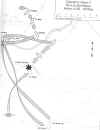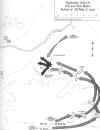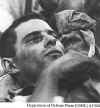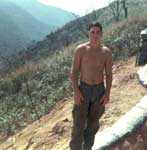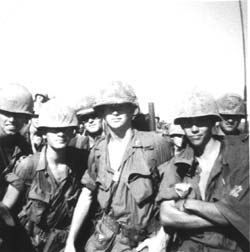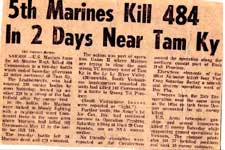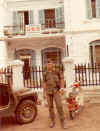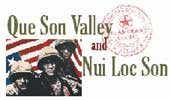This
is not an official USMC combat operations page, but our personal attempt
to recover as much info as we can about the operations participated
in by M Co. 3rd Battalion, 5th Marines in Vietnam. We will be posting
recollections and pictures (when available)sent in by Marines and FMF
Corpsmen who participated in Operation UNION and UNION II. Comments
are from informal emails, phone calls, and other correspondence. All
related pictures and information is greatly appreciated. Operation UNION II The following maps/pics/captions/info photocopied from "U.S. Marines in Vietnam - Fighting the North Vietnamese 1967" by Major Gary L, Telfer, USMC, Lieutenant Colonel Lane Rogers USMC and V. Keith Fleming, Jr. One of the "U.S. Marines in Vietnam Operational History" Series. UNION II, like UNION, involved coordination with the 6th ARVN Regiment and the 1st ARNV Ranger Group. The 1st and 3rd Battalions, 5th Marines once again became the maneuver elements for III MAF's portion of the operation. The operation plan directed Lt. Col. Hilgartner's 1st Battalion to establish blocking positions in the western portion of the valley. The three RVN Ranger Group battalions were to attack southwest from Thang Binh, while two units of the 6th ARVN Regiment were to attack northwest from a position near Tam Ky. Lt. Col. Esslinger's 3rd Battalion would move by helicopters into the southern portion of the basin and sweep northeast. The ARVN named their part of the operation Lien Kit 106. Nui
Loc Son Basin On the morning of 26 May, Esslinger's Marines, three companies and a command group, made a heliborne assault into an area five kilometers east of Nui Loc Son outpost. Company L's first two waves experienced only sniper fire as they landed at LZ Eagle, but as Company M and the command group landed, heavy small arms and mortar fire struck the LZ. At 1134 the enemy defenders shot down a CH-46 over the LZ. As Company I landed, Companies L and M attacked north to relieve the pressure on the LZ. The attacking companies found a well-entrenched enemy force northeast of the landing zone. While artillery and air strikes pounded the NVA positions, Company I moved to the northeast to envelop the enemy's flank, and in the face of strong resistance drove through the position. Fighting continued throughout the afternoon. When the Marines finally overran the last enemy positions at 1630, they counted 118 dead NVA soldiers scattered over the battlefield. The 3rd Battalion lost 38 killed and 82 wounded, including Lieutenant Colonel Esslinger, who was wounded in the eye. While the Marines of Esslinger's battalion engaged the enemy force, Hilgartner's Marines established blocking positions to the northwest as planned. The ARVN ranger and infantry elements closed from the northeast and southeast to box in the enemy. For the next three days, all four forces swept the area. There were only isolated exchanges of fire; once more the 3rd NVA Regiment had withdrawn from the basin. Convinced that the enemy had escaped, the South Vietnamese ended their operation, but Colonel Houghton did not believe that all the NVA forces had left the Que Son region. After anaylyzing available intelligence, Houghton decided to change the direction of attack toward the hills along the southern rim of the basin, southeast of the 3rd Battalion's battle area of the 26th. On 30 May, he had his two battalions flown into the area by helicopter and began a sweep to the northeast. Their advance encountered only long-range sniper fire. By the afternoon of 1 June, both battalions had reentered the basin and moved northwest generally toward the site of the original 26 May contact. Action of 30 May-2 June 1967 On 2 June, the Marines moved out, two battalions abreast, with the 1st Battalion on the right. Objective Foxtrot in the Vinh Huy Village complex was their destination. By 0930, the two lead companies of the 3rd Battalion were under heavy fire from 200 dug-in North Vietnamese troops 1,000 meters east of the scene of the 3rd Battalion's heavy action on 26 May. By 1300, after savage fighting and extensive use of supporting arms, the Marines overran the position. As the companies consolidated and began to evacuate their casualties, a helicopter took a direct hit from a 57mm recoilless rifle, killing one Marine and wounding seven others. While the units of the 3rd Battalion, now commanded by Lieutenant Colonel Charles B. Webster, engaged the enemy, Hilgartner's 1st Battalion pushed forward to relieve the pressure. The battalion moved with Company D on the right and an attached company, Company F, 5th Marines, on the left. About 1130, Company D began crossing a 1,000-meter-wide race paddy that contained a horseshoe-shaped hedgerow. The location of the hedgerow was such that the Marines could not approach it except by crossing the open paddy. When the company was halfway across the field, well-camouflaged NVA troops in fortified positions in the horseshoe opened fire. The enemy fire swept the Marines' front and left flank, catching the left flank platoons in a crossfire. The reserve platoon tried to envelop the enemy, but heavy automatic weapons fire forced it back. The Marines consolidated their positions while artillery and air strikes softened up the enemy fortifications. Company F, commanded by Captain James A. Graham, was in serious trouble on Company D's left. Initially, Graham's unit moved under the cover of air and artillery strikes and encountered only sniper fire. As it began crossing a large open paddy area, a Kit Carson Scout with the company started shooting at several mats of hay lying in the paddy. The NVA had concealed themselves under the mats and the Marines killed 31 of them as the company advanced. As the company continued across the open area, mortar and automatic weapons fire inflicted many casualties. Hardest hit was the 2d Platoon; two concealed enemy machine guns stopped it in the middle of the open field. Captain Graham quickly organized his small headquarters group into an assault unit and attacked through the 2d Platoon's position, forcing the North Vietnamese to abandon one of their guns. With some of the pressure relieved, the platoon moved some of the wounded to a more secure area. Captain Graham then tried to silence the second gun, but was unsuccessful. Wounded twice by this time and with his men's ammunition exhausted, the captain ordered his Marines to move back to friendly positions while he stayed behind to protect a wounded man who could not be moved. The last word over the radio from Captain Graham was 25 enemy soldiers were attacking his position. At 1420, Lieutenant Colonel Hilgarner's CP came under heavy mortar, recoilless rifle, and RPG fire. Despite the extensive use of air and artillery by the Marines, the Communist force was too well dug-in and too big for the battalion to dislodge. Colonel Houghton, advised of the situation, asked for help. Since his 3rd Battalion was already involved in heavy fighting, he asked for the commitment of the division reserve, Lieutenant Colonel Mallett C. Jackson, Jr.'s 2d Battalion, 5th Marines. Major General Donn J. Robertson, a Navy Cross holder who had just assumed command of the division on 1 June, concurred and the 2d Battalion prepared to move out by helicopter to join in the battle. The three companies that made up Lieutenant Colonel Jackson's force for this operation were his own Company E' Company D from the 1st Battalion, 7th Marines' and Company E, 2d Battalion, 7th Marines. The 5th Marines' commander paved the way for the 2d Battalion's entry into the operation by ordering 90 minutes of air and artillery preparation of the planned landing zone. He intended to insert the battalion northeast of the enemy position so it could drive south into the left flank of the NVA force. By 1900, the battalion command group and two companies had landed. They were unopposed and quickly organized the position. As night fell, one of Jackson's companies still had not arrived. Aware of the urgency of the tactical situation facing Hilgartner's battalion, and concerned about the fate of Captain Graham's company from his own battalion, Lieutenant Colonel Jackson requested permission to begin his attack without the missing company. Colonel Houghton concurred. Leaving a security platoon in the landing zone, Jackson maneuvered his force south against the enemy. The battalion had not gone far in the darkness before it collided with an NVA force trying to withdraw to the north. The Marines quickly drove through the Communists and continued south. The 2d Battalion, 5th Marines suffered almost 20 casualties in this initial contact. To evacuate the wounded, the battalion's forward air controller called in a passing CH-53. The pilot landed his helicopter in the middle of the command post, not far from where Company E still engaged the enemy. As Marines completed loading the wounded, an enemy mortar round landed just to the rear of the aircraft and enemy automatic weapons took it under direct fire. The pilot quickly took off. The 2d Battalion later heard that, on its arrival at Da Nang, ground crews counted approximately 58 holes in the helicopter. The sudden presence of a strong force on its northern flank caused the NVA units to disengage and make a hasty withdrawal to the southwest, but the move proved costly. Once NVA soldiers left the protection of their fortifications, they were easy targets for Marine supporting arms fire. Air strike were devastating. On one occasion two F-4 aircraft used an unusual technique of target acquisition which proved especially effective. The first aircraft approached the area at low speed and switched on its landing and running lights. When the enemy fired at the plane, the second aircraft, following closely behind without lights, spotted the enemy and dropped napalm on the firing positions. While supporting arms fire hastened the Communist departure from the battlefield, the 5th Marines spent the night regrouping and evacuating casualties. The following morning, all three battalions swept the battle area. The Marines counted 476 dead North Vietnamese in and around the contested rice paddy and its formidable hedgerow complex. The Marines themselves suffered 71 killed and 139 wounded in the fight. During the sweep of the battle area, Lieutenant Colonel Hilgartner received a radio message from one of his companies that enemy working parties were out collecting the NVA dead. the company commander asked if he should open fire. Hilgarner declined for he saw this as a chance to recover his own dead, including Captain graham's body. For the remainder of the day there was an undeclared truce; the two sides intermingled but ignored each other as they went about collecting their dead. When the enemy main body withdrew, they transported their wounded on two poles lashed together, similar to the "travois" used by the American Plains Indians. The day after the undeclared truce, Hilgartner's battalion tried to follow the travois skid marks but could not catch up with the main body of the NVA force. Halts to call in helicopters to evacuate casualties caused by the enemy's rear guard hindered the Marines' progress. The NVA force escaped. During the last few days of May, two Marine battalions engaged in Operation UNION II searched the rugged mountains found along the southern rim of the Que Son Basin. The action on 2 June marked the last significant battle of UNION II. Total enemy casualties were 701 killed and 23 captured, a favorable ratio to 110 Marines killed (the same number as during UNION I and 241 wounded. Despite the heavy losses suffered during the two UNION operations, throughout the summer the enemy continued to pump replacements into the region in a determined effort to regain control of the Que Son Valley. Elements of III MAF met and thwarted each Communist thrust into the area. Government control was returning to pay a big price in men and material. Low rice paddy dikes provided the only available cover for these men of the 3rd Battalion, 5th Marines after debarking on 26 May from helicopters of HMM-361.This photograph, taken from a helicopter, shows the barrel of the crew's M-60 machine gun. Pfc. George Hase of Company M, 3rd Battalion, 5th Marines reflects on the initial combat of Operation UNION II when casualties sustained from North Vietnamese fire forced him to shift from ammunition carrier to assistant gunner on his machine gun team. The above maps/pics/captions/info photocopied from "U.S. Marines in Vietnam - Fighting the North Vietnamese 1967" by Major Gary L, Telfer, USMC, Lieutenant Colonel Lane Rogers USMC and V. Keith Fleming, Jr. One of the "U.S. Marines in Vietnam Operational History" Series. ************************ Submitted by Fred Riddle
26 May 1967 I joined 3/5 in Tam Ky in late May 1967 right after Operation UNION. They didn't need anymore men on 81's, so the six mortar men that arrived with me were taken to Mike Co. They asked if anyone knew 60's, and I told them I had training in 60's and 81's, so they put me with the 60's section. The other men were distributed among the platoons as regular grunts. After meeting everyone in the section, one of the Marines said something I will always remember, and that was, "He still has the TASTE of the States in his mouth". At the time it seemed like an odd thig to say, but in time I knew what he had meant. I had just enough time to get to know everyone. I was told about UNION and how bad it was, and I just didn't have a clue as to what they were talking about. I was in for a life changing experience that would change my whole way of thinking and makes me feel so close to the Marines I survived with to this day. We were given the word to move out, and it really didn't have a lot of meaning at the time because I still was uaware of what this whole thing I was involved in was about. When we landed I found out, and very quickly. It was the first time being shot at, and the feeling can't be explained unless it has happened to you. Heavy ground fire and mortar fire everywhere. We moved up out of the paddies to a small house with some trees and bamboo bordering it. I don't remember all that was going on, but I remember Cpt. McElroy on the radio and other men in the CP discussing things, but even then though I was around the CP, I had no idea of how things worked. We started to move out to the front right of where we had come in from, and I remember everyone kind of standing around waiting. In a split second everything around me changed. I heard them coming in, but you could not act that fast. Two 82mm mortar rounds landed right in the middle of our group and Marines were down everywhere. After the initial shock of the event (it seemed like hours, but I know was just seconds), I got my senses together and noticed the Marine in front of me was holding his face. I asked if he was ok, and I think he said, "No, I'm not," that's when I noticed the blood. He got his face torn up and part of his right shoulder. That's when I looked at my right shoulder and noticed that my shirt was torn and I was bleeding also. Then I thought about the other guys in the section. I started looking and found several wounded on the ground. I found Rockey, but he looked like he was killed, and I found Harold. Me and him had become friends, and I had an urgent need to see if he was ok. I noticed a Marine that was halfway in an air raid hole on the side of the paddy dike, so I went over. He had his arms up holding onto the dirt wall, but something didn't seem right about it, there was no movement. I yelled to him to see if he was ok, but no response. I pulled him back and removed his pack and started to check him. That's when I came to my senses. This was Harold, my friend, the guy just minutes before I was talking to and sharing my thoughts and my fears about the whole thing, and he was gone. He feared mortar fire more than anything, and almost got to cover, but one small fragment entered through his back and right through his heart. I was in shock. After we cleared the wounded back to the treeline and the dead to another area, we set up a perimeter inside the treed area. We couldn't get the wounded out because of the heavy fire, so the corpsman had to do what he could for them. Because all the mortar section was either KIA or WIA, it didn't exist any longer. I was all that ws left, so I was put in 3rd platoon and assigned to the perimeter on the left side of the treeline. I was watching across the and I noticed small puffs of grayish smoke coming from a area that was heavily wooded. Then it hit me that it was where the mortar fire was coming from, so I left my position and went looking for the FAC officer that was with the CP. I told him that I knew where the mortar fire was coming from and needed him to look for himself. He went with me and I showed him and once the bird dog got into position, they called in a massive air strike on the area. The mortar fire stopped, but the ground fire was still heavy. I remember going into that night, my thoughts of whether it was going to be my last day or not because we were heavily outnumbered. 26 May 1967 was the day, and even though my memory fails me about some things, these events are very clear and I forever will remember Harold and Rocky and their sacrifice.~Fred Riddle *********************************** Submitted by Lynwood Scott
This picture was taken just after UNION II. On May 26, 1967, I was attached to Lima Company as their FAC Team. I was on the third helicopter that landed in the hot LZ that day. The other member of the FAC team was Anthony Russo from Miami, Florida. Russo was wounded that day, and I took over directing the air strikes from the ground. I'm in the center of the picture with the radio, PRC 41, on my back. You can see the short stubby antenna sticking up above my left shoulder. This is the same radio I used to talk to the F-4's and the A-4's that flew in support of us that day. The person next to me with his arms folded is Billy Clark who lives in Amarillo, Texas. He came to mine and Russo's rescue after Russo was wounded. I had only minor wounds from the shrapnel, so I kept calling in the air strikes as Billy helped Russo, who was wounded more seriously. We had so many dead and wounded that day, that I turned the purple heart down because my wounds were minor. Later on June 2, 1967, I was wounded again, so I accepted that purple heart.~Semper fi, Lynwood Scott ****************************** Sea Tiger articles courtesy of Frank Jurney, M/3/5 ****************************************** Submitted by Steve Walker/Haygood
We hit a bunch of resistance in a ville, and got pinned down in a paddy. 1st platoon was more or less on the right flank of an "on line' formation. I was still humping 3.5 rockets. We got pinned down for several hours, and literally could not move. I mean if I moved my head up to look around I got shot at, this was from a position of flat on my stomach. I guess in 4-5 hours, I must of got shot at 15-20 times...close enough to either have dirt kicked up on me, or rounds loud enough and close enough to hurt my ears. I remember one guy that no one liked, he was a real whiner, he just "snapped," and went crazy. He jumped up in the middle of this firefight shouting, "I can't take it anymore! I can't take it anymore! Immediately he got shot a couple of times, and was wounded quite seriously. No one could get to him. I think a Corpsman got wounded trying to get to him. It rattled everybody a little bit because he started crying, and hollering for his mother, and that went on for a maybe an hour or so, and then he quieted down and died. When dusk came, we pulled back maybe a 1/4 mile, and set up for the night, but we didn't dig in. We were told the noise would let the gooks know where our positions were . Anyway about 03:00, word was passed to drop our packs and keep on our "deuce gear"... 782 gear, "web' gear for you civilians! Anyway, we fixed bayonets and moved out to the same tree line that had us pinned all day. We were on line, shoulder to shoulder, with about 5 meter spacing, and about 50 meters from the tree line, the word was passed to put our weapons on full automatic. Everyone was sure the shit would let loose... Just one round of incoming would have been all it took... But, nothing was there. Nothing happened. We went into and through the ville and secured it, and about an hour after sunrise the villagers and village chieftain returned. They told us that the NVA had left just after dark the previous night. In other words, us and them pulled back at about the same time. I don't really remember much more about Union II, it lasted a week or two, and then we rolled right into Adair without leaving the bush. All in all, Union II and Adair was about 2 weeks I believe. During Union II was when Sgt. Craig Sullivan joined our unit, if memory serves me correctly. Semper fi~Steve Walker/Haygood ****************************** Submitted by George Filyaw
It was early around May 23, 1967 or so when my squad was sent TAD to 3/5, it might have been to Lima Company at Tam Ky, my squad of snipers worked with all of the 5th Marines at one time or the other. It was early on the morning of May 26th that I found out about UNION II, my spotter and I grabbed a week's supply and went to the LZ where everyone was saddling up and waiting for choppers to come in from Da Nang. I talked to some officer, and he put us with the squad that was taking the first chopper out. I remember the first chopper loaded, and we headed for the LZ with at least two other choppers right behind us. As we hit the LZ, we took on heavy small arms fire. The other two choppers did not land, and we hit the dried out rice paddies running. My spotter and I was pinned down in the paddies for hours along with the other members of the squad that was on the chopper. The tree line was full of NVA, and we got our share of targets at about three or four hundred yards to the tree line. In a few hours Marines that landed at another LZ fought and drove the NVA from that tree line and secured the area. A squad came out and picked us up, and brought us into the tree line, a young officer called us up to take out a NVA sniper that was taking head shots at the Marines trying to cross an open area. Two Marines led us up the path to where the Marines were taking sniper fire, someone motioned for us to get down. Before I could I took a round in the neck. I was treated by a Corpsman, I don't know who he was, but he had me on a chopper to the field hospital within minutes, THANKS. SEMPER FI~George Filyaw, 5th Marine Scout Sniper Plt. ******************
Presidential Unit
Citation to 5th Marine Regiment for Operation UNION and UNION II
|

